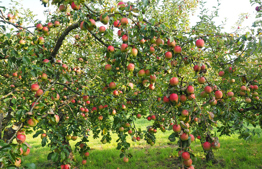Mitzvot Hateluyot Ba'aretz for Land Liberated in the Six Day War

Did Israel's miraculous victory during the Six Day War change the halachic status of the land vis-à-vis land-dependent mitzvot?
In the month of Iyar 5727 (1967), the Arab countries surrounding Israel conspired to destroy the nascent Jewish state. In tandem with the dedicated effort of IDF soldiers, with the help of G-d they were defeated through open miracles. In only six days (from the 26th of Iyar to the 2nd of Sivan), the land of our forefathers whose center contains the location of the former Temple, was redeemed from foreign control.
The Israeli Chief Rabbinate established that the day of Jerusalem’s liberation, the 28th of Iyar, be celebrated as a day of Hallel and praise to G-d for the salvation of the Jewish population in the State of Israel.
The evening of Yom Yerushalayim prior to ma'ariv, the psalms recited on Yom Ha'atzma'ut are also said. Psalm 122 is also added, with some including Psalm 132 as well. The following morning, during shacharit, the psalms normally recited on Shabbat and Yom Tov are included, and Hallel is said with a berachah. It is also proper to have a festive meal with songs and praises to G-d for the miracle.
The Halachic Debate about the IDF's Conquest during the Six-Day War
The tremendous victory of the Six-Day War reignited a debate regarding the halachic ramifications of conquests by the IDF generally, and during the Six-Day War specifically. This is a debate that began subsequently to the Israeli War of Independence, continuing during the Sinai War of 1956, but took on special urgency in the aftermath of the Six-Day War, when enormous tracts of terrain were freed from foreign domination. In addition, halachic questions relating to the sanctity of the Temple and Jerusalem (at least within the Old City walls) became more practical.
Over the ensuing years, much Torah literature was written regarding these questions. Rabbi Eliezer Yehudah Waldenberg dealt with these issues at length in the tenth volume of his Responsa Tzitz Eliezer. Torah VeHa'aretz Institute has published articles on the topic, ranging from the agricultural status of the conquered lands to the redemption of ma'aser sheni within the Old City walls. These articles also included a contribution from the former Chief Rabbi of Israel, Rabbi Shlomo Goren ztz"l (Emunat Itecha 50), which was supplemental to articles he published during his tenure as Chief Rabbi of the IDF. Rabbi Yaakov Ariel also discusses the issues in Responsa Ohala shel Torah (4:42).
In the following sections, we will summarize the halachot connected to the mitzvot hateluyot ba’aretz within the territories conquered by the IDF during the Six-Day War.
The Implication of IDF Conquest for the Obligation of Mitzvot Hateluyot Ba’aretz
- There are those who hold that IDF conquest sanctifies and obligates for mitzvot ha-teluyot ba’aretz even in those places not sanctified during the initial conquest of Joshua (olei Mitzrayim). In addition, it renews the sanctification and obligation in those places initially conquered by Joshua, but not sanctified by those returning during the beginning of the Second Temple period (olei Bavel). The argument is that the IDF represents Jewish authority with the status of a king, acting on behalf of the majority of the Jewish people.
- However, there are those who disagree and claim that IDF conquest does not sanctify and obligate mitzvot ha-teluyot ba’aretz since a court of properly ordained rabbis is required to orally sanctify those places, which currently cannot be assembled.
- This debate has practical relevance for those places with doubtful status vis-a-vis their sanctification during the conquest of olei Mitzrayim, like the Arava region stretching from the south of the Dead Sea to Eilat.
- Bottom line, according to a decision of the Chief Rabbinate of Israel from the founding of the state, one must keep all the laws of mitzvot ha-teluyot ba’aretz in these areas due to their doubtful status.
Terumot and Ma’aserot in the Gaza Strip and Sinai Desert
- Certain halachic decisors have written (already several hundred years ago) that there is no obligation to separate terumot and ma'aserot from what grows in the city of Gaza and her surroundings, even if it had been sanctified by olei Mitzrayim, owing to the fact that this initial sanctification was annulled in the aftermath of the destruction of the First Temple, removing any obligation for terumot and ma'aserot.
- The southern extent of the territory sanctified near Gaza by the olei Mitzrayim is what’s known as Nachal Mitzrayim. Some identify it with Wadi El-Arish south of the city El-Arish, while others claim it refers to the Nile River. A third opinion contends it lies even further east, in the location of the current Suez Canal.
- However, according to most halachic decisors, even though the initial sanctification was annulled, an obligation for all mitzvot ha-teluyot ba’aretz still exists in Gaza.
- After the Six-Day War, there were those who proffered that in consideration of those opinions which ascribe halachic significance to the contemporary conquests of the IDF, one should keep the mitzvot ha-teluyot ba’aretz in these areas, at least out of doubt.
The Contemporary Sanctity of Jerusalem and the Obligation of Terumot and Ma'aserot
- The obligation to separate terumot and ma'aserot from produce which grew in Jerusalem is only a rabbinic one, in a similar fashion to other places sanctified by olei Bavel.
- The sanctity of Jerusalem exists even today, in the entire domain sanctified by King Shlomo. Therefore, it is prohibited to redeem the fruits of ma'aser sheni within present-day Jerusalem, including the City of David, the Jewish Quarter, and according to several decisors, even on Mount Zion (there are those who are lenient and permit redeeming ma'aser sheni produce there). However, one can redeem impure ma'aser sheni produce within Jerusalem. Therefore, when separating terumot and ma'aserot in Jerusalem, before the process of separation begins, the fruit is wetted and touched to induce impurity. But one is forbidden to remove produce from Jerusalem in order to redeem ma'aser sheni outside of the city.
- Nonetheless, despite these laws which relate to Jerusalem as sanctified, it is forbidden to consume ma'aser sheni within the confines of Jerusalem when the Temple is destroyed and all are treated with the status of those defiled by a dead body.
The Golan Heights as Olei Mitzrayim or Olei Bavel
- In the aftermath of its liberation, the halachic status of the Golan Heights has been debated by the decisors of our generation. There are those who treat it as similar to the ever ha-yarden region (east of the Jordan River), which despite being conquered by Moshe, was never commanded to be so. This, in turn, allows for leniency in several mitzvot ha-teluyot ba’aretz. On the other hand, there are those who suggest two reasons for stringency: Firstly, there is a viewpoint which considers ever ha-yarden to be a part of the Galilee and conventional Israel. Secondly, during the Second Temple period, Jewish settlement existed in the northern and central regions of the Golan Heights.
- Therefore, the Chief Rabbinate of Israel ruled that in regards to shemitah and terumot and ma'aserot, the Golan Heights should be treated as a region with the status of olei Bavel, with the exception of specific northern sections to be treated as territory of olei Mitzrayim.
See the Hebrew article here.
Translator: Ephraim Fruchter




